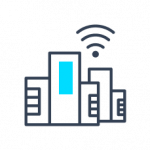A digital twin is a virtual representation of a physical object, process, or system. It’s not just a 3D model: it’s a living, breathing digital entity fed by real-time data from sensors, IoT devices, machines, and software systems. It mirrors the behaviour and condition of its physical counterpart, making it possible to simulate, predict, and optimize outcomes before they happen in the real world. Think of it as the difference between looking at a picture of your car versus having a live feed of its speed, fuel efficiency, tyre pressure, and engine health — all in one dashboard.
Initially used in aerospace and manufacturing, digital twins have evolved into a critical component of the Fourth Industrial Revolution. They’re no longer limited to machines or products; they now represent people, supply chains, buildings, and even entire cities. From monitoring wind turbines in remote areas to optimizing hospital patient flow and predicting traffic patterns in smart cities; the use cases are growing rapidly.
Why Do Digital Twins Matter?
Predictive Maintenance and Efficiency: One of the most impactful applications of digital twins is in predictive maintenance. By continuously monitoring equipment and using historical data, companies can anticipate failures, reduce downtime, and extend the life of their assets. This isn’t just about fixing things before they break, it’s about optimizing performance every step of the way.
Sustainability and Smart Resource Use: Digital twins help companies track energy usage, emissions, and resource consumption in real time. By pinpointing inefficiencies, they empower organizations to make smarter, greener decisions. In buildings, for instance, digital twins can optimize HVAC systems, lighting, and occupancy for both comfort and carbon savings.
Accelerated Innovation: With a digital twin, you can test a new product design or process in a simulated environment before implementing it in the real world. This reduces risk, saves time, and lowers costs, a game-changer for R&D teams.
Enhanced Decision-Making: By integrating data from various sources, including sensors, cameras, ERP systems, and more, digital twins provide a unified view of operations. This holistic perspective supports faster, more accurate decision-making at every level.
Resilience in a Complex World: In uncertain times, resilience is key. Digital twins allow organizations to run “what-if” scenarios and stress tests, helping them prepare for disruptions: whether it’s supply chain bottlenecks, equipment failures, or climate events.
Real-World Applications of Digital Twins

Construction and Real Estate: Digital twins bring Building Information Modeling (BIM) to life. They provide insights into building performance, enable remote facility management, and support sustainable design practices.

Smart Cities: Urban planners are using digital twins to simulate everything from traffic flow to energy consumption. The result? Smarter infrastructure, improved citizen services, and more livable cities.

Healthcare: Hospitals are leveraging digital twins to model patient journeys, optimize resource allocation, and even personalize treatment plans based on digital replicas of individual patients.

Manufacturing: Factories use digital twins for real-time equipment monitoring, optimizing production lines, and simulating worker safety scenarios to improve efficiency and reduce risks.
The Road Ahead: Digital Twins + AI + IoT
The power of digital twins is amplified when combined with Artificial Intelligence and the Internet of Things. AI can analyze twin data to spot anomalies, suggest optimizations, and even automate responses. IoT ensures a constant data stream from the physical world. Together, they create a feedback loop that makes the digital twin smarter over time, making it a continuous learning system. Of course, it’s not all smooth sailing. Data privacy, interoperability between systems, and the high cost of implementation can pose hurdles. But as technologies mature and standardization improves, these barriers are gradually being overcome.
Digital twins aren’t just about digitizing the world. They’re about understanding it better. They offer a powerful lens through which we can rethink operations, reimagine experiences, and reinvent the way we live and work. As we lean into an era defined by complexity, climate urgency, and rapid change, digital twins give us the tools to respond with agility and intelligence.
The future isn’t just smart; it’s mirrored, modelled, and made better by digital twins.